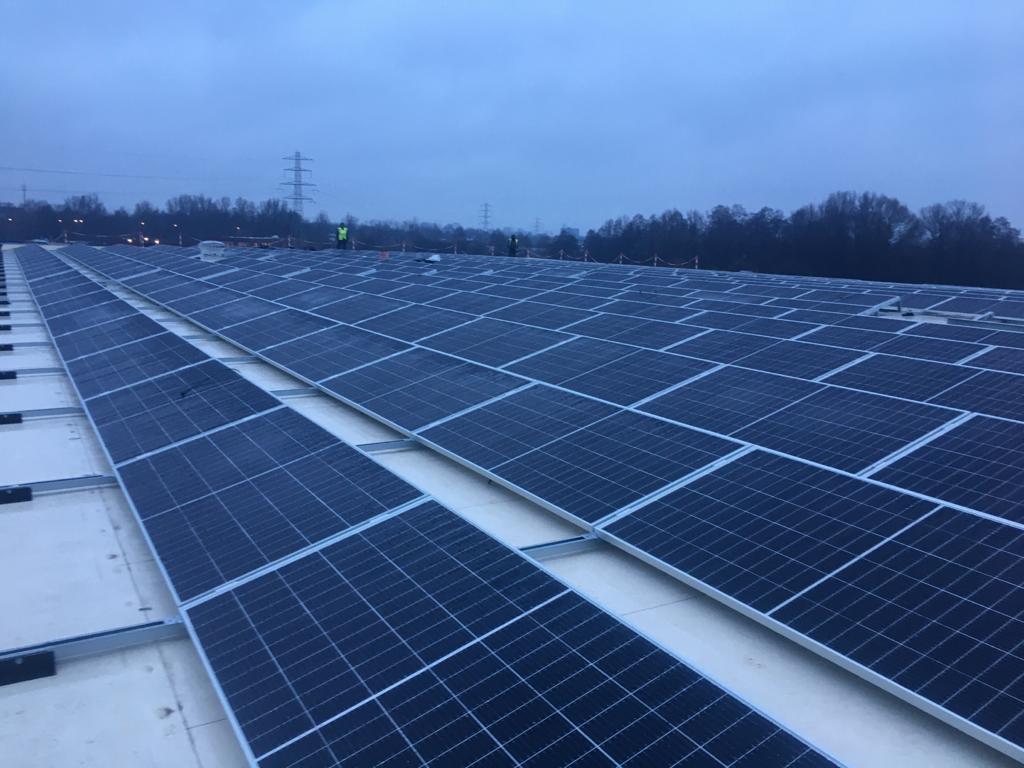Interview with John Arts, Logistic & Facilities Project Manager & Judith Dijkstra, Marketing & Communications Manager
Sustainability is at the heart of what we do.
Sustainability is one of the five core values at Royal Reesink. About seven years ago, the company starts seriously considering reducing their CO2 footprint and defining clear sustainability targets. As a result, nowadays, more than one gigawatt of solar power is generated directly from the company’s locations. Due to their high dedication and the continuous collaboration with SolarAccess, seven rooftops are covered with highly efficient solar installations. And, Reesink is taking sustainable steps in many other areas.
Focus on sustainability.
Judith Dijkstra, Marketing & Communications Manager: “An internal survey amongst all Reesink’ employees revealed that sustainability is one of our five core values. As a company we have a responsibility to contributing to a better world, a cleaner environment. Corporate sustainability is important to us.” Fortunately, Judith says, attention for this subject is increasing across the industry. Customers, government tenders, it’s everywhere. “And at Royal Reesink we are moving forward at high speed, thanks to John Arts and all our colleagues in the Royal Reesink companies.”
As Project Manager Logistics & Facilities, John Arts supports and advises all Royal Reesink companies. John: “About seven years ago we started coordinating the purchase of energy and CO2reduction from our holding company. Mobility is another focus point; our vehicle fleet accounts for a large proportion of our CO2emissions. Our CEO Gerrit van der Scheer emphasizes: ‘Quality of life is important for us, today, but we have to save the planet for future generations as well.’ What are the results of our choices for our planet? That’s the question I ask myself very often.”
CO2 footprint & setting goals.
John: “Step one in our sustainability process was to determine our CO2emissions. We didn’t know exactly what our consumption and emissions were. We drew up an inventory and calculated our footprint, which we have been monitoring ever since.” “This first step brings awareness and is therefore important”, Judith adds. “After that you can start setting targets.” John: “Priority one: the buildings. Reducing electricity consumption by replacing high energy consumers. We want to generate the electricity that we need, despite all savings, locally and sustainably. After investigating our options we decided to give a second purpose to our empty rooftops – solar electricity generators. to fill our empty rooftops with solar panels. Solar energy is an excellent sustainable and profitable investment for us.”
Experienced with large projects.
After a thorough selection process Reesink chose to work with SolarAccess, out of six other parties. John: “During the first project, 408 panels were installed on one of the Reesink premises in Apeldoorn. The collaboration was excellent and SolarAccess became our preferred solar energy supplier. Nowadays seven amazing solar projects have been completed. 3.000 solar panels installed on our locations are reducing app 600 tons of CO2 emissions every year. You can tell that SolarAccess has lots of experience with large industrial solar projects. I am all positive about our partnership, we reinforce each other. Communication lines are short and SolarAccess is a reliable party that I can definitely recommend. Excellent quality and high transparency. During the execution of solar projects you sometimes get questions, about insurance for rental properties for example. In cases like that you notice that SolarAccess is very experienced in large projects and delivers according to the latest safety requirements.”
Additional benefits: awareness and positivity.
The CO2 footprint of Royal Reesink has now been reduced by 26%, according to John, and the purchase of sustainable energy is almost 80%. An achievement to be proud of! In addition, Reesink keeps on improving sustainability in many other areas. Judith: “Electrification and the development of hybrid machines; we want to operate as sustainably as possible throughout the entire chain. For example, we recently launched a fully electric machine for landscaping.” The next big step is the transition to a fully electric fleet for all employees, John adds. Preferably charged with solar power from their own rooftops!
Employees at Reesink are involved in the theme, says Judith. Among other things, an internal campaign (COYou2) has been set up to stimulate awareness, including for example a ‘warm jumper’ day and other little things that everyone can do to reduce CO2 emissions, like turning off computer screens at the end of the workday. Sustainability and saving energy are everyone’s business! John: “Our teams respond positively to the implementation of the solar projects. We are currently installing monitors that show the output of the panels in real-time. It’s great to visualize how much green electricity our roofs are generating day by day. It creates awareness and positivity.”
Fill up those empty roofs!
To organizations that consider investing in solar energy, John and Judith only say: just do it! It is an investment that pays for itself. John: “Fill up those empty rooftops with solar panels! We all have to contribute if we want to achieve the 2050 sustainability targets. Generating energy locally lowers the impact on the electricity network, which is estimated to be heavily loaded in the coming years. Making your factories and offices self-sustainable is a wonderful goal. It’s financially advantageous while giving an amazing feeling of doing the right thing.”









